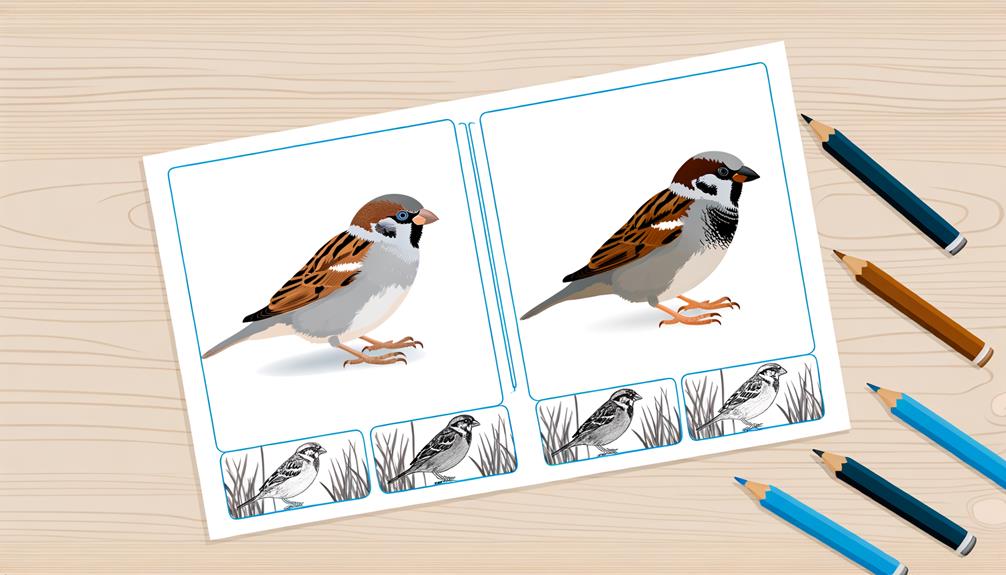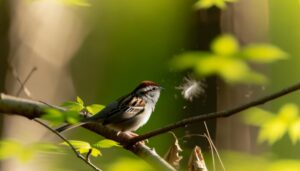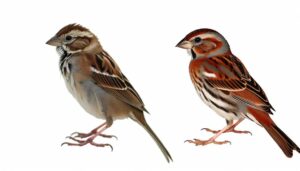10 Key Differences Between Eurasian Tree Sparrows and House Sparrows
The Eurasian Tree Sparrow and House Sparrow are distinct species within the passeridae family. Eurasian Tree Sparrows are smaller, around 12.5-14cm in length, with a chocolate-brown head and a white cheek with a black patch.
Contrastingly, House Sparrows are slightly larger and males have a gray head with a chestnut nape. Habitat-wise, both species adapt well to urban and rural areas but differ in nesting habits.
Understanding the threats they face and their conservation status provides insights into the environmental impact on these creatures. The fascinating dynamics of these species offers a more profound exploration of their unique characteristics.

Key Takeaways
- The Eurasian Tree Sparrow is smaller (12.5 – 14 cm) than the House Sparrow, which is about 16 cm in length.
- Both species have adapted to urban and rural environments, but House Sparrows often nest in man-made structures, while Eurasian Tree Sparrows use various locations.
- Both species feed on diverse diets including seeds, grains, and insects, but House Sparrows also consume nectar and scraps.
- House Sparrows breed from March to August with peak breeding in spring, while Eurasian Tree Sparrows breed in early spring for two broods per year.
- The House Sparrow is more robust with a compact body, short powerful legs, and stubby beak, while the Eurasian Tree Sparrow has a chocolate-brown head with a white cheek and a black patch.
Understanding Sparrows: An Overview
To fully grasp the nuances between the Eurasian Tree Sparrow and the House Sparrow, understanding the general characteristics, behaviors, and habitats of sparrows as a species is essential.
Sparrows are small, plump, brown-grey birds with short tails and stubby, powerful beaks. They're highly social, often seen in large flocks, and they're known for their robust, clear, and continuous chirping.
They thrive in diverse environments, from rural to urban settings, making their nests in trees, shrubs, and man-made structures. Their diet primarily consists of grains and seeds, but they'll also consume small insects when available.
They're not migratory, opting to brave the winters rather than seek warmer climates. This adaptability, resilience, and social nature contribute to the worldwide distribution of sparrows.
Historical Background of Eurasian Tree Sparrows
Building on the basic understanding of sparrows, we find the Eurasian Tree Sparrow holds a captivating history that sets it apart from its counterparts. Native to the temperate regions of Europe and Asia, this species is scientifically known as Passer montanus. Its ability to adapt to various environments has led to its widespread presence across the continents.
Surprisingly, the Eurasian Tree Sparrow's population in North America is largely confined to the vicinity of St. Louis, Missouri, a consequence of deliberate introductions in the 19th century. These sparrows aren't migratory, typically remaining in the same locale year-round. Their distinct double cheek patches and chestnut crown, as well as their unique historical background, contribute to the rich tapestry of sparrow diversity.
Historical Background of House Sparrows
Often overshadowing its Eurasian Tree Sparrow cousin due to its widespread presence, the House Sparrow, or Passer domesticus, boasts an equally intriguing history.
Originally native to Eurasia and North Africa, it's now found globally, save for the polar regions, thanks to human migration. Its proliferation dates back to the Neolithic era when humans evolved from hunters to farmers. The sparrows, adaptable and opportunistic, found the grain-rich agrarian communities to be ideal habitats.
Scientists believe house sparrows accompanied early settlers on their voyages, leading to their global presence. Despite their ubiquity, in recent decades, a decline in their population in several regions, including Europe and North America, has sparked scientific curiosity and concern.
Physical Characteristics of Eurasian Tree Sparrows
Sporting a distinct chocolate-brown head and nape, the Eurasian Tree Sparrow, or Passer montanus, showcases a unique set of physical features that set it apart from its House Sparrow counterpart. As a measure of its size, this bird's length typically ranges from 12.5-14 cm, with a wingspan around 21 cm. It's identifiable by a conspicuous black patch on each pure white cheek. The sexes are similarly colored, which is a significant departure from many bird species where males are more vibrantly colored.
Below is a comparison chart of key physical features:
| Feature | Description |
|---|---|
| Size | 12.5 – 14 cm in length |
| Wingspan | Approximately 21 cm |
| Head color | Chocolate-brown |
| Cheek color | White with black patch |
| Sexes | Similarly colored |
These features make the Eurasian Tree Sparrow distinct in its appearance.
Physical Characteristics of House Sparrows
Moving from the Eurasian Tree Sparrow, attention now shifts towards the House Sparrow, with a focus on its distinct physical attributes. Detailed examination will involve the color patterns, size, and body shape that set this species apart.
Additionally, the discussion will highlight any notable features that further distinguish the House Sparrow from its Eurasian counterpart.
House Sparrow's Color Patterns
Displaying a fascinating range of colors, the House Sparrow boasts a distinctive pattern: males typically have a gray head and chestnut nape, while females exhibit a more subdued palette of browns and buffs.
These color variations not only distinguish the sexes but also play essential roles in the sparrows' survival and mating strategies.
To appreciate this intricate avian coloration, consider the following details:
- Males' gray and chestnut hues are likely linked to their dominance and attractiveness to females.
- The females' more muted colors aid in camouflaging them, especially during nesting periods.
- Seasonal changes can slightly affect the sparrows' color intensity.
- Juvenile sparrows display a blend of their parents' color patterns until maturity.
- The sparrows' color patterns may vary slightly based on their geographical location, showcasing remarkable adaptability.
Size and Body Shape
House Sparrows, compact powerhouses of the avian world, have a robust body shape and size that equip them for their adaptive urban lifestyle. Measuring about 16 centimeters in length, they exhibit a stout build, typically weighing between 24 to 39.5 grams.
This species' size facilitates survival in diverse environments, from bustling cities to rural landscapes. They possess a broad, rounded body, providing a large surface area to volume ratio, advantageous for heat conservation in colder climates.
Their short, powerful legs and stubby beak reflect their granivorous dietary habits, enabling effective foraging and seed-cracking. Overall, the House Sparrow's size and body shape reflect an evolutionary design optimized for versatility, endurance, and adaptability, essential for thriving in an ever-changing world.
Notable Sparrow Features
Let's explore the unique physical characteristics of House Sparrows, which set them apart in the avian world. These sparrows have a robust build, often described as 'chunky' or 'stout', contributing to their resilience in diverse environments.
Here are some notable features:
- *Size*: House Sparrows typically measure 16 cm in length and weigh around 24 to 39.5 grams.
- *Coloration*: These birds exhibit sexual dimorphism, with males having a gray head, chestnut nape, and black bib, while females are duller with brownish hues.
- *Beak*: They possess a strong, conical beak, perfect for cracking seeds.
- *Wings*: Short, rounded wings aid in their agile flight.
- *Tail*: Their tail is usually grayish, short, and notched.
These characteristics assist in their adaptability and survival in both urban and rural settings.
Habitat Preferences: Eurasian Tree Sparrow
Regarding habitat preferences, the Eurasian Tree Sparrow demonstrates a unique adaptability to both urban and rural environments. Their nesting site preferences, frequently in cavities of trees or buildings, further showcase the species' versatility.
Seasonal changes also play a significant role in influencing this species' choice of habitat, suggesting a dynamic relationship between the bird's behavior and its environment.
Urban and Rural Adaptability
Adapting to both urban and rural environments, the Eurasian Tree Sparrow demonstrates an impressive range of habitat preferences. This adaptable bird thrives in a variety of settings and conditions, showcasing a high level of resilience and adaptability.
The Eurasian Tree Sparrow's urban and rural adaptability can be attributed to the following key factors:
- The bird's ability to find food sources in diverse environments, from city parks to farmland.
- Its resilience in facing varying climatic conditions, such as harsh winters and hot summers.
- The ability to utilize different types of shelter, from trees to buildings.
- Its capacity to avoid common urban and rural predators.
- The species' robust reproductive cycle, which allows it to maintain healthy population levels in varying habitats.
Understanding these factors is essential for effective conservation efforts.
Nesting Site Preferences
What're the nesting site preferences of the Eurasian Tree Sparrow, you might wonder?
This species tends to favor areas that provide an abundance of food and safety from predators. Unlike its relative, the House Sparrow, the Eurasian Tree Sparrow often nests in natural environments such as tree holes, cliffs, and even old woodpecker cavities.
This isn't to say that they don't adapt to man-made structures; they've been known to nest in buildings, bridges, and nest boxes if suitable natural sites are scarce.
The nest is usually constructed with grass, feathers, and other soft materials. Moreover, this species doesn't mind nesting in close proximity to humans, providing a unique opportunity to observe their behavior first-hand.
Impact of Seasonal Changes
Seasonal changes bear significant influence on the habitat preferences of the Eurasian Tree Sparrow, altering their choice of nesting sites and feeding grounds. As the seasons shift, these sparrows demonstrate remarkable adaptability, modifying their behavior and habitat preferences to deal with the changing environmental conditions.
- In spring, they prefer areas with emerging vegetation, as this provides abundant food resources and suitable nesting material.
- During summer, they favor cooler areas with ample shade and water sources.
- In autumn, they gravitate towards areas with a high concentration of insects and seeds.
- Winter sees them seeking shelter in dense vegetation or human-made structures to protect against harsh weather.
- Throughout the seasons, Eurasian Tree Sparrows remain in close proximity to human settlements, indicating their adaptability to diverse habitats.
Habitat Preferences: House Sparrow
House sparrows, remarkably adaptable creatures, mainly prefer human-altered environments, often nesting in both urban and rural settings with a striking bias towards buildings, streetlights, and other man-made structures. This preference is likely due to the abundance of food, nesting sites, and relative safety from predators in such habitats.
Consider this table which succinctly summarizes the preferred habitats of house sparrows:
| Habitat Type | Reason for Preference | Impact on Sparrow Survival |
|---|---|---|
| Urban Settings | Abundance of food & nesting sites | High survival rates |
| Buildings | Protection from predators | High survival rates |
| Rural Areas | Less competition for resources | Moderate survival rates |
From the analysis, it's clear that the house sparrow's survival strategy leans heavily towards human-altered environments, a reflection of their adaptability. This has implications for their conservation and potential conflicts with humans.
Dietary Habits of Eurasian Tree Sparrows
Diversification marks the dietary habits of Eurasian Tree Sparrows, as they feed on a wide variety of food sources, ranging from seeds and grains to insects and fruits. Their adaptability allows them to thrive in diverse habitats, from rural farmlands to urban areas.
Eurasian Tree Sparrows primarily consume:
- Seeds: Constituting a significant part of their diet, they feast on seeds from a variety of plants.
- Grains: They're known to forage in farmlands for grains like wheat and oats.
- Insects: During breeding season, these sparrows increase their intake of protein-rich insects.
- Fruits: These birds also consume fruits, particularly berries, adding to their diversified diet.
- Human food waste: In urban settings, they often feed on scraps, showcasing their adaptability.
Their diet highlights their ecological role in seed dispersal and insect control.
Dietary Habits of House Sparrows
Just as their Eurasian relatives, House Sparrows also display a wide-ranging diet, but with a few distinct differences worth analyzing. House Sparrows primarily feed on grains and seeds, especially those of cultivated cereals.
However, they're not strict granivores. Their diet also includes insects, especially during the breeding season, when high-protein sustenance is essential for their offspring's growth.
House Sparrows occasionally supplement their diet with nectar and household scraps, showcasing their opportunistic feeding behavior. Interestingly, their dietary adaptability has contributed remarkably to their global distribution.
Yet, this varied diet isn't without consequences. It's thought that changes in agricultural practices, particularly the reduction in winter stubble, have led to notable declines in some House Sparrow populations.
Breeding and Nesting: Eurasian Tree Sparrows
The breeding and nesting habits of the Eurasian Tree Sparrow offer a fascinating study into their survival and propagation strategies.
These sparrows exhibit a variety of nesting habitats, each with its unique characteristics and implications on their lifecycle.
Further, an analysis of their breeding season and unique nesting behaviors reveals intricate details about their reproductive strategies, underpinning their adaptability and success as a species.
Nesting Habitats Explored
Eurasian Tree Sparrows, remarkable for their adaptability, mainly choose cavities in trees and buildings for nesting, exhibiting a fascinating variety in their habitat selection. These birds demonstrate a surprising versatility, making use of any suitable crevice for their nesting needs, prioritizing safe, enclosed spaces over specific materials or locations.
- They often nest in holes in trees, both naturally occurring and those left by woodpeckers.
- Buildings, particularly older ones with many cracks and crevices, are a favorite.
- Occasionally, they use birdhouses if the dimensions and entrance hole are suitable.
- They've been known to nest in cliff crevices or even in ground burrows.
- They can use the old nests of other birds, especially if located in a cavity or crevice.
Their nesting behavior reveals their impressive adaptability, exploiting a diverse range of environments to secure their survival.
Breeding Season Insights
Interestingly, Eurasian Tree Sparrows begin their breeding season in early spring, often starting nesting activities as soon as the frosty conditions ease and the days start to lengthen. This timing aligns with the availability of sufficient food resources, especially insects, crucial for the growth and survival of their offspring.
They typically produce two broods per year, with each clutch usually containing five to six eggs. The eggs are oval-shaped, smooth, and display a shiny white appearance, often speckled with light brown or gray spots.
Both parents participate in the incubation process, which lasts for about 12 to 14 days. The fledging period extends to around 15 to 20 days, during which time the young sparrows are looked after by both parents.
Unique Nesting Behaviors
Adapting to a variety of environments, Eurasian Tree Sparrows exhibit several unique nesting behaviors that set them apart from other bird species. They show a remarkable ability to use a diverse range of nesting sites, from natural tree cavities to man-made structures.
- Eurasian Tree Sparrows often choose nest sites that are high off the ground, providing safety from predators.
- They're known to use both natural and artificial nesting sites, including buildings and nest boxes.
- Unlike some bird species, Eurasian Tree Sparrows often reuse the same nest site year after year.
- The female Eurasian Tree Sparrow typically builds the nest, while the male defends the territory.
- These sparrows lay an average of five eggs per clutch, with both parents sharing incubation duties.
Understanding these behaviors can enhance our appreciation of these adaptable and resilient birds.
Breeding and Nesting: House Sparrows
Despite their urban prevalence, House Sparrows exhibit a fascinating breeding and nesting behavior that's marked by distinct seasonal patterns and site preferences. They typically breed between March and August, with peak activity in the spring. Their nests, often built in man-made structures, comprise an array of materials, from feathers to plastic strips. Remarkably, House Sparrows frequently reuse and refurbish old nests, displaying a notable resourcefulness.
| Breeding Season | March – August |
|---|---|
| Peak Breeding Time | Spring |
| Nesting Sites | Man-made structures |
| Nest Materials | Feathers, grass, plastic strips |
| Nest Reusability | High |
This pattern of behavior, while seemingly mundane, offers intriguing insights into the adaptability of House Sparrows in diverse environments, contributing significantly to their widespread distribution and success as a species.
Threats and Conservation Status: Eurasian Tree Sparrow
Switching over to the Eurasian Tree Sparrow, it's worth noting that this species faces a unique set of threats that heavily influence its conservation status. Despite being widespread, the Eurasian Tree Sparrow's population is in decline. This is largely due to the following factors:
- Habitat loss: Urbanization and agricultural intensification are eradicating the bird's natural habitat.
- Predation: Cats, snakes, and birds of prey pose significant threats.
- Climate change: Extreme weather events and shifting seasons disrupt their breeding patterns.
- Pesticides: Chemicals used in farming can poison these birds indirectly.
- Disease: Avian malaria and other diseases can decimate populations.
These factors, individually and collectively, have a profound impact on the Eurasian Tree Sparrow's conservation status, driving the need for concerted conservation efforts.
Threats and Conservation Status: House Sparrow
Similar to the Eurasian Tree Sparrow, the House Sparrow also faces its own set of challenges and threats that greatly affect its conservation status. Urbanization, habitat loss, and changes in agricultural practices are the primary threats, leading to a significant decline in their population, especially in Europe.
The introduction of non-native species also poses a competitive threat to its survival. According to the IUCN Red List, the House Sparrow is currently classified as 'Least Concern', despite the population decline. This status, however, requires regular reassessment given the ongoing threats.
Conservation efforts should focus on habitat preservation and improved agricultural practices. Public education about the species' importance and its coexistence with humans may also prove beneficial.
Conclusion
To wrap up, while both the Eurasian Tree Sparrow and the House Sparrow share similarities, they also exhibit fascinating differences.
For instance, despite their similar size and coloring, the Eurasian Tree Sparrow's nesting habits differ notably, with only 10% of them nesting in buildings compared to 90% of House Sparrows.
These distinctions highlight the importance of studying and conserving these species individually, despite their seemingly similar appearances.






